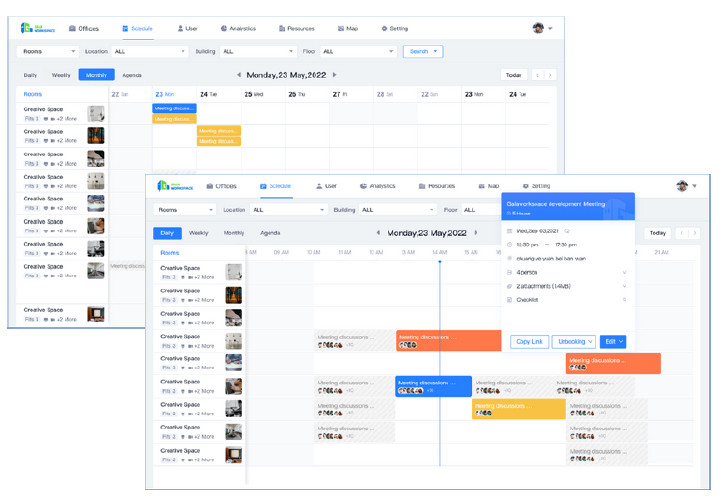The world is facing a climate crisis, and it’s imperative that we take significant steps to reduce our carbon dioxide (CO2) emissions. One often overlooked area where emissions can be reduced is in the workplace. Recently, the term “ESG” becomes popular worldwide. What is ESG? ESG stands for environmental, social, and (corporate) governance. It is a set of practices used to evaluate a company’s operational performance as it relates to social and environmental impact. This evaluation can be done internally or externally by investors or other stakeholders. This blog will talk about green workspace from ESG “environment” perspective. As organizations embrace hybrid work models, combining both in-office and remote work, they have an opportunity to optimize their office spaces and reduce carbon footprints. In this blog, we’ll explore how hybrid workspace modes, coupled with room and space scheduling software, can play a crucial role in reducing CO2 emissions and promoting sustainability.
The Hybrid Workspace Revolution
The COVID-19 pandemic forced businesses worldwide to reevaluate their work structures. Hybrid work arrangements, combining remote and in-office work, have become the new norm. This shift presents a unique opportunity for organizations to reduce their carbon emissions. Here’s how:

Reduced Commuting
Daily commuting has long been a pillar of the traditional work model, but it’s also a significant contributor to global carbon emissions. Millions of employees worldwide rely on vehicles for their daily commutes, resulting in emissions of greenhouse gases and pollutants. This not only impacts air quality but also congests road networks and demands considerable energy resources. The adoption of a hybrid work model, where employees work from home part-time and visit the office efficiently, presents a remarkable opportunity to reduce these emissions.
By allowing employees to work remotely part of the time, businesses can significantly cut the carbon footprint associated with employee travel. Reduced vehicle emissions from commuting are a central benefit. Fewer cars on the road mean lower emissions of carbon dioxide, nitrogen oxides, and particulate matter. This approach also mitigates traffic congestion, which not only wastes time but exacerbates environmental issues. Moreover, the energy consumption associated with transportation systems, such as public transit and road networks, decreases as commuting frequency drops.
Furthermore, telecommuting offers a multitude of environmental advantages. Remote workers often optimize their time, resulting in shorter, more productive workdays that require fewer commutes. Additionally, employees may make eco-friendly choices in their home environment, further reducing their carbon footprint. Embracing a hybrid work model isn’t just an ecological win; it also contributes to improved air quality in cities and fosters a healthier work-life balance for employees. Businesses play a pivotal role in tackling climate change by reshaping their approach to commuting, optimizing office visits, and championing a greener, more sustainable future.
Optimized Office Space
Hybrid work models demand a dynamic approach to office space utilization, fundamentally altering the way companies view their physical workplaces. Instead of maintaining large, underused spaces, businesses have a unique opportunity to downsize their office footprint. This not only optimizes the utilization of existing resources but also significantly contributes to sustainability goals.
One key aspect of this shift is the reduction in energy consumption. With fewer employees physically present in the office on any given day, heating, cooling, and lighting requirements are significantly diminished. This translates into substantial energy savings and a reduced carbon footprint. By embracing a more streamlined physical workspace, companies can align their operational needs with their environmental responsibilities.
Moreover, downsizing office spaces often leads to cost savings, which can be reinvested in sustainable initiatives. Companies can channel these resources into adopting eco-friendly technologies, implementing renewable energy solutions, or enhancing their sustainability programs. Additionally, smaller office footprints often mean less material consumption and a lighter environmental impact throughout the construction and maintenance lifecycle of office spaces. In essence, a flexible approach to office space utilization under the umbrella of hybrid work models not only boosts efficiency but also aligns businesses with their sustainability objectives, marking a positive step towards a greener future.
Resource Conservation
As businesses transition to hybrid work models with a reduced in-office presence, a significant positive outcome is the conservation of resources. With fewer people in the office, there’s a direct reduction in resource consumption, leading to a smaller environmental footprint. This extends across several critical areas of resource management.
Firstly, reduced energy usage is a substantial gain. A smaller number of employees physically present translates to lower energy demands for heating, cooling, and powering the office. This not only results in cost savings but also decreases the carbon emissions associated with energy production. Lower energy consumption aligns with global efforts to combat climate change by reducing the overall demand for fossil fuels.
Secondly, the decrease in paper consumption is noteworthy. The traditional office setting often involves a significant amount of paper use for documents, reports, and meetings. With more tasks transitioning to digital platforms and less reliance on physical copies, businesses can save trees and reduce the environmental impact of paper production, including water usage and chemical pollution.
Lastly, water conservation plays a part in the environmental equation. Fewer employees in the office mean reduced water consumption for restrooms, kitchens, and other facilities. This not only saves water resources but also reduces the energy required for water treatment and distribution.
In essence, the transition to a hybrid work model goes beyond reducing carbon emissions; it encompasses a broader commitment to sustainable practices. Fewer people in the office directly correlate with fewer resources consumed, and this resource conservation is a tangible contribution to a greener, more environmentally responsible workplace.

Room and Space Scheduling Software: A Key Enabler
To make the most of hybrid workspace modes for reducing CO2 emissions, organizations need an efficient and intuitive way to manage office spaces. This is where room and space scheduling software comes into play:
Optimized Space Allocation: Scheduling software allows businesses to efficiently allocate office space based on employee needs. For instance, meeting rooms can be reserved only when necessary, preventing the unnecessary use of resources and energy.
Resource Management: These software solutions can manage resources like HVAC systems, lighting, and other utilities more intelligently. They can automatically adjust settings based on occupancy and schedule, reducing energy waste.
Real-time Data: Many scheduling tools provide real-time occupancy data, enabling organizations to make informed decisions about space usage and allocation. This data can also help identify underused areas that can be repurposed or downsized to reduce environmental impact.
Remote Collaboration: Hybrid work models require seamless communication between in-office and remote workers. Scheduling software often integrates with collaboration tools, making it easier for remote employees to join meetings and interact with their in-office counterparts, further reducing the need for travel.
Case Studies in Sustainability
Several companies have already embraced the hybrid workspace mode and leveraged room and space scheduling software to reduce their carbon emissions. Let’s take a look at three notable examples:
- Microsoft: Microsoft adopted a “hybrid workplace” strategy, allowing employees to choose from three work options: working from home, working from the office, or a combination of both. They utilized space scheduling software to manage office space efficiently, reducing the need for a sprawling physical footprint and the associated environmental impact.
- Salesforce: Salesforce implemented a “work from anywhere” model, encouraging employees to work remotely or in the office. Their room scheduling software integrated with occupancy sensors, helping them maximize space utilization while minimizing energy consumption in unused areas.
- Yokogawa: Yokogawa is facing one of the challenges — High Office Energy Cost and Responsibilities for Emission. The potential for increased energy prices due to the ongoing conflict between Russia and Ukraine becomes another challenge for Yokogawa. To solve this problem, Yokogawa is looking at ways to reduce the temperature and office area to save on energy costs. Unlike a lot of American high-tech companies that drive people back to the office without remote work mode anymore, Yokogawa expects to build up a more sustainable office mode.
Gaia Workspace helps them solve this problem. To migrate to the hybrid office mode, the office manager removed one floor and more than 80 assigned desks. Based on the job category, they keep the assigned desks for those people who need come to the office regularly and set hotelling desks for the people who can work flexible and remote. All the area and settings are marked on the intuitive floor plan with difference color and icons.
Then the office manager set up the booking rules for the rooms and desk separately, which automate the facility booking process and save managers a lot of time. During the transformation, the office management team also realized the team need more and more collaboration areas and meeting spaces for in-person and hybrid meetings, then the team just transform the redundant area into meeting area to improve the collaboration activities.
For most big organizations are saturated with enterprise applications, it is reluctant for the employees to use the new applications. Therefore, Gaia Workspace Team just integrate the solution with Azure AD to retrieve all the organization’s members, integrate with Microsoft Teams and Outlook, which make the solution is easy to use and without leave the daily office applications.
Conclusion
The hybrid workspace model, coupled with room and space scheduling software, offers a powerful strategy for reducing CO2 emissions in the workplace. By optimizing office space, conserving resources, and reducing the need for commuting, businesses can contribute significantly to the fight against climate change. Sustainability isn’t just about what happens outside the office; it’s about how we manage the spaces where we work. As more organizations embrace this approach, we move one step closer to a greener, more sustainable future.

